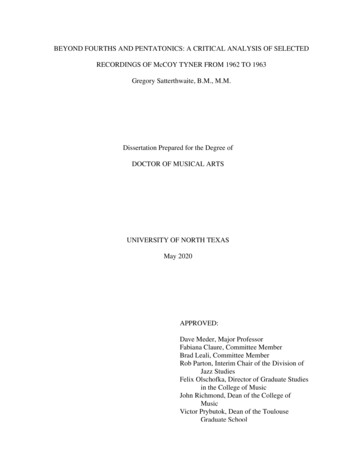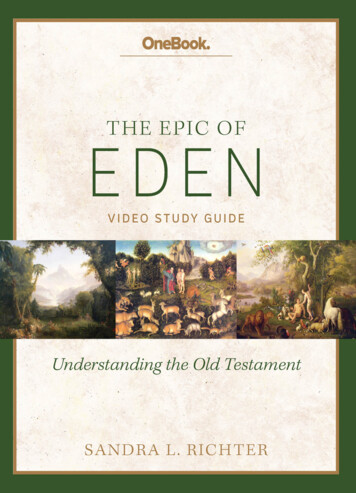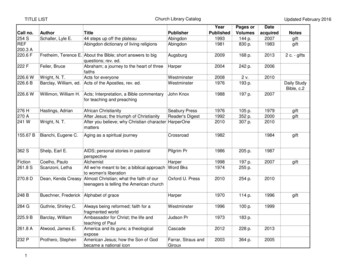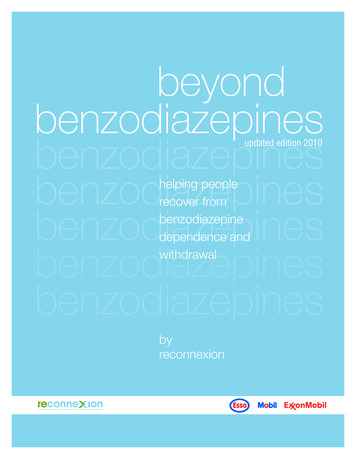
Transcription
BEYOND FOURTHS AND PENTATONICS: A CRITICAL ANALYSIS OF SELECTEDRECORDINGS OF McCOY TYNER FROM 1962 TO 1963Gregory Satterthwaite, B.M., M.M.Dissertation Prepared for the Degree ofDOCTOR OF MUSICAL ARTSUNIVERSITY OF NORTH TEXASMay 2020APPROVED:Dave Meder, Major ProfessorFabiana Claure, Committee MemberBrad Leali, Committee MemberRob Parton, Interim Chair of the Division ofJazz StudiesFelix Olschofka, Director of Graduate Studiesin the College of MusicJohn Richmond, Dean of the College ofMusicVictor Prybutok, Dean of the ToulouseGraduate School
Satterthwaite, Gregory. Beyond Fourths and Pentatonics: A Critical Analysis of SelectedRecordings of McCoy Tyner from 1962 to 1963. Doctor of Musical Arts (Performance), May2020, 37 pp., 1 table, 11 musical examples, 3 appendices, bibliography, 48 titles.In this paper, I explore the early musical language of McCoy Tyner. Today, Tyner isrecognized mostly for his use of quartal harmony and pentatonic scales despite having maderecordings in his early career that reflect a more mainstream approach. In an effort to expandhow Tyner is represented, I argue that Tyner’s early style was characterized by a gracefulbalance of tradition and innovation, a masterful blend of bebop syntax with pentatonic melodiesand quartal harmonies. The recordings that I analyze and discuss are: “Effendi,” “Cousin Mary,”and “Newport Romp.” I transcribed and analyzed selected portions of these recordings in orderto better understand his early musical language as a soloist from 1962 to 1963. A portion of thispaper is focused on the early reception of Tyner, which acknowledged him as an accomplishedmainstream player with a firm grasp of the jazz tradition. Ultimately, my analysis shows thatTyner’s early style was a balance of tradition and innovation, incorporating bebop syntax,pentatonic melodies, and quartal harmonies.
Copyright 2020ByGregory Satterthwaiteii
ACKNOWLEDGEMENTSI would like to thank all of the faculty at the University of North Texas. I am verygrateful to my committee members Dave Meder, Brad Leali, and Dr. Fabiana Claure for theirsupport throughout this project and my time at UNT. I am thankful for the mentorship of Dr.John Murphy and Stephen Scott. Thank you Dr. John Murphy for your patience, encouragement,and passion. Thank you Stephen for your friendship and for sharing so much beautiful musicwith me. My journey at UNT would have not been possible without the love and support of myFather and Mother. Thank you to my incredible wife Samika for your love and supportthroughout this process and over the years. I love you Christian and Ellison; keep striving.iii
TABLE OF CONTENTSPageACKNOWLEDGEMENTS . iiiLIST OF TABLES AND MUSICAL EXAMPLES . vCHAPTER 1. INTRODUCTION AND THESIS . 1Literature Review. 3Method . 6CHAPTER 2. BACKGROUND . 8CHAPTER 3. CRITICAL RECEPTION . 10Early Reception before Coltrane . 10Reception with Coltrane . 13CHAPTER 4. ANALYSIS OF RECORDINGS . 16“Effendi” . 16“Cousin Mary” . 19“Newport Romp” . 23CHAPTER 5. CONCLUSION. 26APPENDIX A. “EFFENDI” (TYNER SOLO 0:30-0:53) . 27APPENDIX B. “COUSIN MARY” (TYNER SOLO 0:25-1:36). 29APPENDIX C. “NEWPORT ROMP” (TYNER SOLO 0:22-1:05) . 32BIBLIOGRAPHY . 35iv
LIST OF TABLES AND MUSICAL EXAMPLESPageTablesTable 1: Cell A-Tyner’s idiom, Cell B- bebop dialect. 21Musical ExamplesAll musical examples are my own original transcriptions of the cited sources. These musicalexamples are a fair use of copyrighted work as allowed on section 107 from The Copyright Actof October 19,1976.Example 1: “Effendi,” Tyner solo mm. 1-9 (0:30-0:38). 17Example 2: “Effendi,” Tyner solo mm. 5-16 (0:34-0:49) . 18Example 3: “Effendi,” Tyner solo (1:49-1:50) . 19Example 4: “Cousin Mary”, Tyner solo mm. 53-57 (1:16- 1:20). 20Example 5: “Cousin Mary,” mm. 24–32 (0:47– 0:53). 21Example 6: “Cousin Mary”, Tyner solo mm. 29-33 (0:52- 0:56). 22Example 7: “Cousin Mary,” Tyner solo mm. 46 -50 (1:09- 1:12). 22Example 8: “Newport Romp,” Tyner solo mm. 10-24 (0:31-0:43) . 23Example 9: “Newport Romp,” Tyner solo mm. 35-45 (0:53-1:01) . 24Example 10: Bebop Lick . 25Example 11: “Newport Romp” Tyner solo mm. 45-49 (1:02-1:06) . 25v
CHAPTER 1INTRODUCTION AND THESISMcCoy Tyner is one of the most celebrated jazz musicians of his generation. Hecollaborated with many notable jazz artists including John Coltrane, Freddie Hubbard, andWayne Shorter. Tyner influenced several generations of pianists, including Chick Corea, JohnHicks, Harold Mabern, Jan Hammer, Richie Beirach, Mulgrew Miller, Kenny Kirkland, DaveKikoski, George Cables, Jim McNeeley, and John Medeski.1 Tyner came of age in the 1950s andwas influenced by the great bebop pianists Bud Powell and Thelonious Monk. Tyner made hisfirst recording in 1959 at the age of 21, and, in the six decades since, recorded dozens more.Jazz artists are often known and celebrated for the features that make them unique. DizzyGillespie is known for his virtuosity, Thelonious Monk for his minimalism, and Miles Davis forhis lyricism and melodicism. But jazz is also an art from that celebrates the tradition as much asit does innovation. The great jazz artists of every era sought a balance of these competingaesthetic values.Today, Tyner is recognized mostly for his use of quartal harmony and pentatonic scales.This is not entirely unfair. Indeed, Tyner was one of the first pianists to explore these featuresextensively and make them an integral part of his sound. However, prior to being known forthese innovations, Tyner was recognized as a proficient mainstream player. As Dick Katz notesin his Oxford Music Online article, Tyner “was an accomplished bebop player who was at homeplaying standards.”2 Jazz scholar Paul Rinzler distinguishes between Tyner’s mainstream, bebop,1Keith Waters, "Tyner, (Alfred) McCoy," Grove Music Online (January 13, 81561592630-e-1002276732, (accessed September 25, 2019).2Dick Katz, “Pianist of the 1940s and 1950s,” The Oxford Companion to Jazz (2000): 371.1
and his quartal and pentatonic approach, characterizing the former as “not such an important partof his unique special sound.”3 Although Rinzler does not criticize Tyner’s mainstream playing,he does not identify it as part of what made Tyner’s playing special. Rinzler’s statement seems tocapture the widespread sentiment that only innovation makes a contribution to jazz special.That general sentiment is reflected in the fact that most extant literature about Tyner hasfocused on his use of pentatonics and fourths to the exclusion of other interesting features ofTyner’s playing. This can mislead students and educators into a limited understanding of thebreadth of Tyner’s musical legacy. I want to expand how McCoy Tyner is represented. To thatend, I argue that Tyner’s early style was characterized by a graceful balance of tradition andinnovation, a masterful blend of bebop syntax with pentatonic melodies and quartal harmonies.In this paper, I examine Tyner’s musical language as a soloist from 1962 to 1963 in order tobetter understand his early musical style.The recordings that are analyzed and discussed are: “Effendi,”4 “Cousin Mary,”5 and“Newport Romp.”6 “Effendi”7 is from Tyner’s first album as a leader. Analyzing a recording inwhich Tyner takes the role as a leader is important because it highlights his voice in a moreunfettered, personal, and prominent way that is not under the influence of another soloist.“Effendi”8 is a modal composition and a vehicle for Tyner to employ some of his characteristicmusical techniques. He improvises with bebop-oriented syntax mixed with non-traditional3Paul Rinzler, “The Quartal and Pentatonic Harmony of McCoy Tyner,” Annual Review of Jazz Studies 10 (January1, 1999) 37.4McCoy Tyner, Inception, recorded on January10, 1962, master number A-18, Impulse!.5John Coltrane, Afro Blue Impressions, recorded on November 2, 1963, master number PL 2620-101, PabloRecords.6McCoy Tyner, Live At Newport, recorded on July 5, 1963, master number, A-48, Impulse!.7McCoy Tyner, Inception, recorded on January10, 1962, master number A-18, Impulse!.8Ibid.2
melodic patterns consisting of fourths and chromatic harmony.Both “Cousin Mary”9 and “Newport Romp”10 are based on a blues form. They provide aninteresting study because they each demonstrate Tyner’s ability to outline chord changes usingbebop dialect while still incorporating many elements that are unique to him. Both tunes arefairly up-tempo pieces that illustrate just how adept Tyner was at mixing the musical language ofbebop with his own unique approach.Literature ReviewPaul Rinzler has written two extensive articles on McCoy Tyner’s style, syntax, andharmony. “McCoy Tyner: Style and Syntax,” comprises single-note transcriptions and analysesof five recordings, including “Blue Monk,”11 “May Street,”12 “The Night Has a ThousandEyes,”13 “Impressions,”14 and “Moment’s Notice.”15 Rinzler states that the pieces were chosenbecause each one has stylistic demands which make the application of a modal or blues-basedapproach to improvisation challenging. The main analytical tool used by Rinzler is structuralhierarchy, where the lowest level would be individual notes and higher levels are groups of noteswhich form syntactic relationships.16 Rinzler asserts that the combination of chromaticism andpentatonicism is an essential part of Tyner’s sound.17 Rinzler characterizes Tyner’s melodic9John Coltrane, Afro Blue Impressions, recorded on November 2, 1963, master number PL 2620-101, PabloRecords.10McCoy Tyner, Live At Newport, recorded on July 5, 1963, A-48, Impulse!.11McCoy Tyner, Nights of Ballads and Blues, recorded on March 4, 1963, master number A-39, Impulse!.12McCoy Tyner, Time for Tyner, recorded on May 17, 1968, master number BST 84370, Blue Note.13McCoy Tyner, Song for My Lady, recorded on November 2, 1972, master number MSP9044, Milestone.14McCoy Tyner, Trident, recorded on February 18th and 19th , 1975, master number M -9063, Milestone.15McCoy Tyner, Supertrios, recorded on April 9th and 10th, 1977, master number M -55003, Milestone.16Paul Rinzler, “McCoy Tyner: Style and Syntax,” The Annual Review of Jazz Studies 2 (1983): 110.17Ibid., 123.3
approach on all the songs as modal and pentatonic. “Blue Monk”18 is the only piece in Rinzler’sstudy where Tyner’s performance is more rooted in the bebop tradition. Rinzler analysis of “BlueMonk”19 highlights Tyner’s use of mixolydian modes and chromatic scales. Rinzler’s book TheQuartal and Pentatonic Harmony of McCoy Tyner20 provides a thorough study of Tyner’sharmonic approach. Rinzler explains the way Tyner constructs bass lines and uses dyads. Heprovides theoretical explanations for many musical examples.There have been numerous method books written about McCoy Tyner’s style. Many ofthem focus exclusively on his use of quartal voicings in modal music and his use of pentatonicmelodies in his improvisation. In Post-Bop Jazz Piano,21 John Valerio states that John Coltraneevolved the concept of modal jazz first introduced by Miles Davis and Bill Evans. Valeriodescribes Tyner’s left-handed and two-handed quartal chords, modal patterns, and right-handmodalization concepts.22 In The Jazz Theory Book,23 Mark Levine references Tyner’s recording“Peresina”24 when describing the “So What”25 voicings that he employs. He also references otherTyner recordings on his chapter on fourth voicings and cites Tyner as the first pianist in the early1960s to play them extensively.2618McCoy Tyner, Nights of Ballads and Blues, recorded on March 4, 1963, master number A-39, Impulse!.19McCoy Tyner, Nights of Ballads and Blues, recorded on March 4, 1963, master number A-39, Impulse!.20Paul Rinzler, “The Quartal and Pentatonic Harmony of McCoy Tyner,” Annual Review of Jazz Studies 10(January 1, 1999).21Valerio, John. Post-Bop Jazz Piano (Milwaukee, WI: Hal Leonard, 2005).22Ibid, 65.23Mark Levine, The Jazz Theory Book (Petaluma, CA: Sher Music Co., 1989), 105.24McCoy Tyner, Expansions, recorded on August 23, 1968, master number BST 84338, Blue Note.25Miles Davis, Kind of Blue, recorded on March 2nd and April 22nd, 1959, master number 88697-33552-2,Columbia.26Ibid, 105.4
In his article “Apart Playing: McCoy Tyner and Bessie’s Blues,”27 Benjamin Givanstates that Tyner’s playing on the recording “Bessie’s Blues”28 exemplifies the traditionalAfrodiasporic performance practice of “apart playing.” Givan credits this term to art historianRobert Farris Thompson, and defines it as “whenever individual performers enact different,complementary roles in an ensemble setting.”29 Givan writes that apartness is applicable to otherfamiliar features of jazz improvisation including harmonic substitutions and playing “outside” agiven harmony and scale. I do not analyze “Bessie’s Blues”30 in this study; however the conceptof “apart playing” is used to think about Tyner’s stylistic approach in the recordings of thisstudy.In a 1960 interview with Al McFarlane for Black Scholar, Tyner opined on theconnection between the blues, the pentatonic scale, and Africa, suggesting that several emergingjazz styles of the 1960s and 1970s represent a direct expression of African-Americanculture.31As Tyner explained:The blues originally came from Africa. The blues is really based on a five-note scalewhich is African, or Eastern and Middle Eastern.It was just black people’s concept ofmusic before they came here.There’s some talk about the American or Europeaninfluence on our music, but again, the five-note scale is African.32Tyner’s view suggests one reason he seems to have increasingly favored the use of pentatonicscales in his own music: it was a way of celebrating African-American culture.27Benjamin Givan, “Apart Playing: McCoy Tyner and Bessie’s Blues,” Journal of the Society for American Music 1(2007).28John Coltrane, Crescent, recorded on April 27th and June 1st, 1964, master number A-66, Impulse!.29Benjamin Givan, “Apart Playing: McCoy Tyner and Bessie’s Blues,” Journal of the Society for American Music 1(2007): 257.30John Coltrane, Crescent, recorded on April 27th and June 1st, 1964, master number A-66, Impulse!.31Al McFarlane, “The Black Scholar Interviews: McCoy Tyner,” The Black Scholar 2/2 (1970): 40.32Benjamin Givan, “Apart Playing: McCoy Tyner and Bessie’s Blues,” Journal of the Society for American Music 1(2007): 185.5
According to jazz historian Mark Gridley, Tyner borrowed from Bill Evans’s chordvoicings but was not as influential as Evans was.33 Gridley describes various elements of Tyner’sapproach, which include his use of fourths and pentatonics and his percussive style of comping.In Jazz from Its Origins to the Present,34 authors Lewis Porter and Michael Ullman also claimthat Tyner was not as influential as Evans and describe Tyner’s approach as “steel driving.”35Another source that helped to provide historical and social context in understanding thedevelopment of Tyner’s style is Alton Merrell’s dissertation “The Life and Music of McCoyTyner: an Examination of the Sociocultural Influences on McCoy Tyner and His Music.”36Lewis Porter’s biography of John Coltrane was also used to gain insight into the life of Tynerduring the early 1960s.MethodFor this project, I used an analytical method modeled on Benjamin Givan’s approach tostudying the improvisational style of Sonny Rollins in terms of intraopus style (the style asexpressed in a single work), idiom (a performer’s individual improvisational vocabulary), anddialect (the improvisational vocabulary shared by a group of musical collaborators).37 Thismethod of analysis allowed me to clearly delineate between Tyner’s idiom and the bebop dialect.Tables and music transcriptions are used to illustrate his idiom versus mainstream jazz dialect.33Mark C. Gridley, Jazz Styles History and Analysis (Newark: Prentice-Hall, 2000), 270.34Lewis Porter and Michael Ullman. Jazz from Its Origins to the Present (Englewood Cliffs: Prentice-Hall, 1993).35Ibid, 336.36Alton Merrell Louis, II."The Life and Music of McCoy Tyner an Examination of the Sociocultural Influences onMcCoy Tyner and His Music" (Ph.D. diss., University of Pittsburgh, 2013), 27.37Benjamin Givan, “Gunther Schuller and the Challenge of Sonny Rollins: Stylistic Context, Intentionality, andJazz Analysis,” Journal of the American Musicological Society, Vol. 67, No. 1 (Spring 2014): 211.6
My musical analysis is based on common practice and jazz theoretical concepts as presented byDavid Baker,38 Jerry Coker,39 Mark Levine.4038David Baker, How to Play Bebop 1 (Van Nuys, CA: Alfred Publishing Co., 1988).39Jerry Coker, Elements of the Jazz Language for the Developing Improvisor (Van Nuys, CA: Alfred PublishingCo., 1991).40Mark Levine, The Jazz Theory Book (Petaluma, CA: Sher Music Co., 1989).7
CHAPTER 2BACKGROUNDTyner acknowledges his mother as a great musical influence on him, as noted in AltonLouis’s work in 2013, “I owe my training to my mother who was once a church pianist. Ourparents play such an important part in our shaping.”41 The Great Migration of the early 1900screated cities with close knit communities of young African American musicians who wouldoften gather to exchange musical ideas. Bud Powell lived in the same neighborhood as Tyner andgave him a lesson or two while Tyner was still a teenager.42Tyner was raised in a thriving, musical, African-American community in Philadelphia.His mother Beatrice Tyner worked as a domestic worker upon arrival to Philadelphia, but herentrepreneurial spirit led her to eventually start her own beauty salon. She was supportive ofMcCoy Tyner’s musical talent and bought a spinet piano for him on credit. She allowed him toput the piano in the salon and permitted him to have jam sessions there while she serviced herclients.43Like many artists, Tyner was influenced by teachers in grade school. His elementarymusic teacher Violet Addison was a pianist whose playing left quite an impression on Tyner. Inmiddle school, Tyner studied for a year with Mr. Habershaw, who taught Tyner the fundamentalsof the piano and music notation.44 At the age of fourteen, Tyner studied with Ted Baroni, whoexposed him to the music of the European classical tradition and cultivated his reading and41Alton Merrell Louis, II."The Life and Music of McCoy Tyner an Examination of the Sociocultural Influences onMcCoy Tyner and His Music" (Ph.D. diss., University of Pittsburgh, 2013), 27.42Ibid.43Ibid.44Ibid, 46.8
technical piano skills.45 Tyner furthered his formal music education at the Granoff School ofMusic, in Philadelphia. At the time he attended, it was one of the largest music institutions of theeast coast, rivaling schools such as Juilliard and the Curtis Institute. Tyner studied seventeenthcentury theory at the Granoff school. Tyner counts the works of Debussy and Bach as some ofhis favorites during his formal years of study.46Jazz saxophonist John Coltrane also influenced Tyner and incorporated world music,Eastern music, classical music, and many other genres into his performances with Tyner. Tynercontinued to evolve as an artist after joining Coltrane and all their past musical influences cametogether in a fresh and creative way. Tyner opined on creative expression and the formal study ofmusic:What written music does is it can show you the possibilities of what you can do with theinstrument [piano] It can’t teach you to be creative. It’s not meant to do that. It just cantake you places that you may not have gone in terms of music It’s all notated I likedstudying, but I put the books away and I took my theoretical knowledge and informationthat I had gathered harmonically, and I went that way.47Tyner’s open mindedness helped him to create a diverse body of work that explored newdirections in music. His mastery of the piano certainly points to a grounding in music as a resultof serious study of many styles.45Alton Merrell Louis, II."The Life and Music of McCoy Tyner an Examination of the Sociocultural Influences onMcCoy Tyner and His Music" (Ph.D. diss., University of Pittsburgh, 2013), 47.46Alton Merrell Louis, II."The Life and Music of McCoy Tyner an Examination of the Sociocultural Influences onMcCoy Tyner and His Music" (Ph.D. diss., University of Pittsburgh, 2013), 47.47Ibid., 49.9
CHAPTER 3CRITICAL RECEPTIONEarly Reception before ColtraneTyner’s first professional recording was with the Curtis Fuller sextet on December 17,1959. He then recorded with the Art Farmer and Benny Golson Jazztet in February of 1960.Tyner was making quite a wave in the jazz scene in the early 1960s even though he was only inhis early twenties. An article by George Hoefer in January of 1960 details the reaction of arecord executive upon hearing Tyner perform with the Jazztet at the Jazz Gallery club onopening night: the executive was begging the Jazztet’s manager to record Tyner’s group andapparently there was a bidding war between several labels to be the first to record the Jazztet.48Hoefer goes on to state that, “part of the group’s success is due to Benny Golson’s discovery inPhiladelphia of a 20-year-old pianist named McCoy Tyner, whose playing is impressingeveryone.”49 Benny Golson, co-leader of the Jazztet, remarked that Tyner, “proved to be a mostimportant person of the Jazztet.”50 Tyner’s playing with the Jazztet could be aptly characterizedas in the tradition of mainstream jazz. This shows Tyner’s respect and understanding of themusic of his predecessors and his early style is certainly rooted in this tradition.Tyner appeared on Freddie Hubbard’s 1960 debut album Open Sesame.51 This albumfeatures compositions in the hard-bop and post-bop traditions. John A. Tynan gave OpenSesame52 three and half stars and described the album as “exciting”53 and Tyner as “one of the48George Hoefer, “The Hot Box,” Down Beat 27, no. 2 (January 1960): 42.49Ibid.50David B. Bittan, “Meet The Jazztet,” Down Beat 27, no. 11 (May 1960): 19.51Freddie Hubbard, Open Sesame, recorded on June 19, 1960, master number BLP 4040, Blue Note.52Freddie Hubbard, Open Sesame, recorded on June 19, 1960, master number BLP 4040, Blue Note.53John A. Tynan, “Open Sesame,” Down Beat 28, no.2 (January 1961): 31.10
most stimulating young piano men to emerge in a long time.”54 The title track, “Open Sesame,”55is a composition that is rooted in the hard bop tradition and features a solo by Tyner that exhibitshis mastery of the bebop dialect. His playing is reminiscent of the great hard bop pianists of the1950s including the likes of Richie Powell, Sonny Clark, and Kenny Drew. This review and thearticle by Hoefer show that both the critics and Tyner’s peers deemed his playing to be excellentand even special enough to be the main attraction of an all-star group.Inception56 was Tyner’s first album as a leader. This trio recording on the Impulse! labelwas recorded on January 10th and 11th in 1962. The rhythm section included Steve Davis on bassand Elvin Jones on drums, the same members that had earlier performed on Coltrane’s recordingMy Favorite Things.57 This album captures Tyner in the midst of a musical transition. On thisalbum, Tyner uses original compositions as a vehicle for more modal explorations while hisinterpretation of jazz standards features a more mainstream approach. The Downbeat review ofthis album is positive overall and highlights the album’s blending of modal and mainstream jazz.Barbara Gardner describes Tyner as a pianist of substance who articulates long flowingstatements. The review goes on to describe the album as a good showing for a 23-year-oldpianist who is receiving a lot of attention because of his association with high profile groups.58Tyner’s second album as a leader, Reaching Fourth,59 was recorded on November of1962. He is joined by Roy Hanes on drums and Henry Grimes on bass. Like Inception,60 this trio54John A. Tynan, “Open Sesame,” Down Beat 28, no.2 (January 1961): 31.55Freddie Hubbard, Open Sesame, recorded on June 19, 1960, master number BLP 4040, Blue Note.56McCoy Tyner, Inception, recorded on January10, 1962, master number A-18, Impulse!.57John Coltrane, My Favorite Things, recorded October 21st, 24th, and 26th, 1960, master number SD-1361, Atlantic.58Barbara Gardner, “Inception,” 29, no. 28 Down Beat (November 1962): 35.59McCoy Tyner, Reaching Fourth, recorded on November 14, 1962, master number A-33, Impulse!.60McCoy Tyner, Inception, recorded on January10, 1962, master number A-18, Impulse!.11
album is a mix of jazz standards and original compositions. Tyner’s arrangement of the standard“Old Devil Moon”61 uses modal vamps, pentatonic-based improvisation, and bebop-orientedlinear material. As he did in “Effendi,”62 Tyner here employs ostinato bass figures throughoutthis arrangement. His voicings are more quartal-based and his improvisation more pentatonicbased during these ostinato figures. He also uses chromaticism over the ostinato figures. Hisimprovisation is also very bebop-oriented, particularly over the part of the song where there are alot of minor to dominant chord progressions. The title track “Reaching Fourth”63 features whatcan be described as intervallic playing, where Tyner is arranging intervals in interesting ways tocreate new melodies. Don Nelsen gave the album four and a half stars in a Downbeat article onJuly 18, 1963. He describes the album as well planned, well executed, and successful in evokingseveral moods.64Harvey Pekar’s April 29, 1963 Downbeat review of Tyner’s third album, Nights ofBallads & Blues,65 is worth noting because he compares it to Tyner’s recordings with Coltrane,writing that, “while his playing on some of these tracks is not as adventuresome as it has beenwith Coltrane, this set is still above average in quality.” He goes on to add that, though somebetter examples of Tyner’s playing can be found on Coltrane albums, most jazz piano fans willenjoy the album.66 Pekar, like many critics both past and present, was more interested in Tyner’swork with Coltrane than Tyner’s work as a trio leader.61McCoy Tyner, Reaching Fourth, recorded on November 14, 1962, master number A-33, Impulse!.62McCoy Tyner, Inception, recorded on January10, 1962, master number A-18, Impulse!.63McCoy Tyner, Reaching Fourth, recorded on November 14, 1962, master number A-33, Impulse!.64Don Nelsen, “Reaching Fourth,” Down Beat 30, no. 16 (July 1963): 27.65McCoy Tyner, Nights of Ballads and Blues, recorded on March 4, 1963, master number A-39, Impulse!.66Harvey Pekar, “Nights of Ballads & Blues,” Down Beat 30, no. 24 (August 1963): 27.12
The reviews from Downbeat testify to Tyner’s prowess as an accomplished mainstreamplayer and show that his early style was very well received. The caliber of the musicians withwhom he worked and the opinions of his reviewers are a testament to the importance of his preColtrane and pre-modal contributions. The early reception of Tyner by the critics and his peerswas very positive. He was described by Benny Golson as integral to the Jazztet ensemble andmost critics regarded him as a promising up and coming musician. His style on many of theseearly recordings is very much inside the mainstream; fourths and pentatonics are not yet adefining part of his sound, but he nevertheless already had a unique voice that can be heard sincehis debut album. The reviews describe him as someone with great potential.Reception with ColtraneTyner left the Jazztet to join the Coltrane quartet in 1960. Tyner’s first album withColtrane was titled Live at the Jazz Gallery.67 He would go on to record several prominentalbums with Coltran
melodies in 21his improvisation. In Post-Bop Jazz Piano, John Valerio states that John Coltrane evolved the concept of modal jazz first introduced by Miles Davis and Bill Evans. Valerio describes Tyner’s left-handed and










